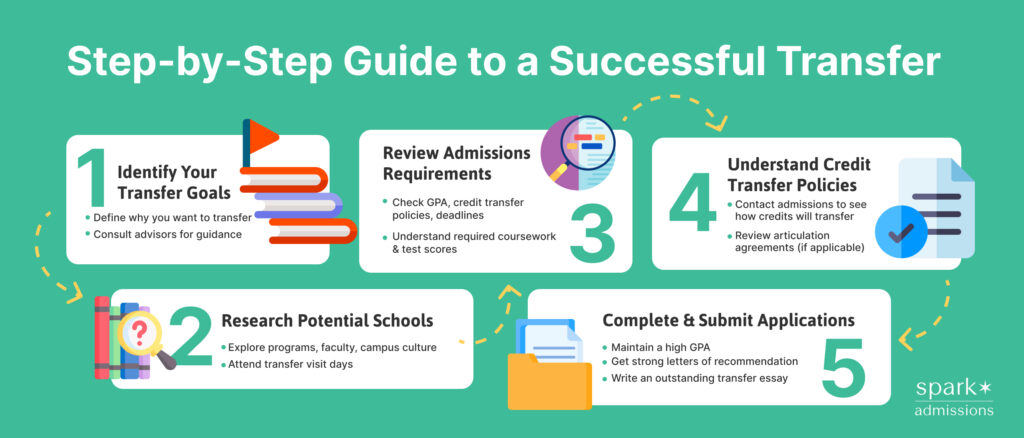- Blog
- > College Admissions
How to Transfer Colleges (Step-by-Step Guide for 2025)
- Dr. Rachel Rubin
- | January 3, 2025

Choosing to transfer colleges is a significant decision. If you’re considering it, understanding the college transfer process is the first step towards making the right choice for your academic future.
According to U.S. Department of Education research, more than a million students are enrolled as transfer students at American institutions each year! The reasons why are enormously varied, including students transferring into or out of community college, students seeking better financial aid, students moving from two-year to four-year institutions, students moving between four-year universities, and more. All of which is to say, if you’re thinking of transferring, you’re definitely not alone!
The college transfer process has some commonalities with the first-year application process, but there are also some key differences. If you’re thinking of applying to transfer, it’s crucial to understand those differences so you can move to a new school that’s right for you.
Understanding the College Transfer Process
Transferring colleges involves several key steps, from identifying your reasons for transferring to successfully integrating into a new academic environment. Each stage requires careful consideration and planning to ensure a smooth and successful transition.
What Is a Transfer Student?
A transfer student is anyone who begins their higher education at one institution and then decides to switch to a new school to complete their degree. This applies to students moving from community colleges to four-year universities, as well as those transitioning between two four-year institutions.
Transfer students bring unique experiences and perspectives to their new campuses. Often, they have a clearer understanding of their academic goals and a greater sense of independence.
Navigating a new environment can be challenging, but transfer students typically find themselves well-equipped to adapt and thrive in their new academic setting. They contribute to the diverse fabric of the college community and bring a wealth of experience.
Common Reasons for Transferring Colleges

Students choose to transfer colleges for a variety of reasons, all aiming to find a better fit for their academic, financial, or social needs. Sometimes, the current school doesn’t offer the desired major or the right learning environment. Other times, financial constraints or a desire for a different location might necessitate a change.
Perhaps the college experience you envisioned doesn’t align with the reality of your current school. Maybe you yearn for a more vibrant campus life, smaller class sizes, or opportunities for research within your field. Some of the most common scenarios are:
- College students at four-year colleges who, for academic or personal reasons, want to attend a different four-year school to finish their degree program;
- College students at two-year, associate’s degree institutions, like community colleges, who want to transfer to a four-year college to receive a bachelor’s degree;
- College students who earned credits in a two- or four-year school but have been out of school for a sustained period and want to reenter higher education;
- College students enrolled in degree programs at international institutions who want to finish their degrees at U.S. colleges and universities.
Whatever the reason, it’s crucial to acknowledge your needs and identify institutions that can better cater to your academic aspirations and personal growth.
Preparing for Your College Transfer
Before embarking on the transfer journey, laying a strong foundation is key. To do so, you must gather the necessary documents, research potential transfer schools, and understand the application requirements.
By being proactive and organized, you can streamline the application process and increase your chances of acceptance into your desired institution. Remember, a well-prepared applicant is a successful applicant.
What You Need to Get Started
The college transfer application process differs slightly from the first-year application. You’ll still need your high school transcript, but now, college transcripts and letters of recommendation from college professors become crucial components, too.
Gaining clarity on how your college credits will transfer to the new institution is essential. Contact the admissions office of your prospective colleges to determine how your credits will be evaluated and if there are any specific course requirements for transfer students.
Remember, starting early is key. The sooner you begin, the more time you’ll have to research, prepare, and submit a strong application that reflects your capabilities and potential contributions to your new academic community.
Gathering Necessary Documents and Resources
Having all your documents in order is vital for a smooth application process. Here’s a checklist to guide you:
| Document | Description |
| Official High School Transcript | Shows your high school coursework and grades, often required even for transfer applicants. |
| College Transcript(s) | Official records of all courses taken and grades earned at your current college and any previous colleges you attended. |
| Letters of Recommendation | Request these from professors who know you well and can speak to your academic abilities and potential. |
| SAT/ACT Scores (if applicable) | Some colleges require standardized test scores for transfer applicants. Just as with first-year admissions, more and more schools are now test-optional and do not require these scores. Furthermore, many universities waive the standardized test score requirement for transfer students who have taken a certain number of credits, usually 2+ years of college at the time of enrollment. Check the specific requirements of your target institutions. |
| Financial Aid Documents | If you plan to apply for financial aid, gather necessary documents like the FAFSA. |
| Personal Statement | A well-crafted personal statement highlighting your reasons for transferring, academic goals, and how the new institution aligns with your aspirations. |
Additionally, there are two very common forms that you’ll need to keep track of, too. These are the College Report, through which your current school says you’re in good standing, and the Mid-Term Report, in which your current professors project your semester grades. Similar forms were likely part of your first-year college admissions process, too, but your guidance counselor almost certainly handled them. Now, it’s up to you to take the College Report to your school registrar and the Mid-Term Report to your teachers.
Finally, some colleges and universities will ask you to complete additional essays beyond the personal statement. You’ll need to check the specific requirements at your target institutions to find the prompts and word limits for these essays.
Early preparation not only helps in submitting a complete application but also demonstrates your commitment to the transfer process.
Step-by-Step Guide to Transferring Colleges with a Strong Application

Strong transfer applicants have much in common with strong first-year applicants: they have a clear goal they want to accomplish, strong grades and scores (where relevant), active involvement on campus at their current schools, and enthusiastic letters of recommendation.
We’ve broken down the entire process of how to transfer colleges into manageable steps to make the transition as seamless as possible. By tackling these steps one by one, you’ll be able to navigate the process confidently and increase your chances of a successful transfer.
Remember, thoroughness and attention to detail are key throughout each step. Let’s explore what each stage entails and what you need to consider along the way.
Step 1: Identify Your Transfer Goals
First, it’s important to understand why you want to transfer schools. Does your current school have insufficient lab or research opportunities in your field? Did your academic program face significant cuts? Is the student body too large, too small, too homogeneous? Does the career advising at your current school not meet your needs? Do you need to be closer to your family for personal reasons?
Discussing your motivations for transferring with your current academic advisor or transfer admissions consultant can provide valuable insights. They can help you explore program options, understand transfer credit policies, and offer guidance based on your academic record.
Clearly defining your goals will guide your research and help you identify institutions that align with your aspirations for a fulfilling and successful college experience.
Step 2: Research Potential Transfer Schools
Once you’ve identified your transfer goals, start researching potential colleges that align with your ambitions. Explore their programs, faculty, research opportunities, and campus culture.
Visiting colleges as a prospective transfer student is as important as it was when you were in high school. Many colleges offer transfer visit days, where you can speak with a designated transfer counselor, learn about resources for transfer students, and meet current students who transferred. These visits will help you decide which schools to apply to and signal to schools that you are serious about attending if admitted.
Connect with the admissions office and inquire about transfer student resources, support services, and opportunities to connect with current college students. Gaining firsthand perspectives from those who have already transitioned into the school can offer invaluable insights into the campus environment.
Remember, the best-ranked college isn’t necessarily the best fit for you. Focus on finding an institution that meets your individual needs and provides the support you need to flourish.
Step 3: Review Transfer Admissions Requirements
Each college has specific admissions requirements for transfer students. Visit the admissions section of each college’s website to understand their criteria, which may include minimum GPA requirements, required coursework, letters of recommendation, essays, and standardized test scores.
Take note of application deadlines, which often differ from regular admission deadlines. Make a checklist of materials required for each institution and note any supplemental essays or forms you need to complete.
Remember, it’s your responsibility to ensure your application is complete and submitted on time. Start the process early to avoid missing any crucial steps or deadlines, giving yourself ample time to present a strong and well-prepared application.
Step 4: Understand Credit Transfer Policies
One of the most critical aspects of transferring colleges is understanding how your college credits will transfer to the new institution. Colleges have varying transfer credit policies, and some may have articulation agreements with specific colleges or community colleges.
Reach out to the registrar’s office at each potential transfer school to determine which of your credits will transfer and how they will apply towards your intended degree program. They can provide a transfer credit evaluation based on your transcripts.
Knowing how your credits will transfer helps you make informed decisions about which schools align best with your academic timeline. Aim to maximize the transferability of your credits to ensure a smooth transition and avoid losing valuable time and resources.
Step 5: Complete and Submit Your Applications
With a firm grasp of your transfer goals, potential schools, and their requirements, it’s time to start your applications. Create a schedule to manage deadlines and dedicate sufficient time to each application.
Carefully review the required materials for each institution and ensure every document is complete, accurate, and submitted on time. Pay attention to detail and proofread everything thoroughly, including your personal statement, which should articulate your reasons for transferring and how the new institution aligns with your goals.
Here are some tips to maximize the strength of your transfer application:
Maintain a High GPA at Your Current College
Having good grades was important the last time around, but it’s doubly important as a transfer applicant. Whereas college admissions officers have to imagine what kind of college student a high school student will be, they can see it plainly for a transfer student! For this reason, your college coursework and grades are paramount in your transfer application.
It’s especially crucial that you have good grades in your major coursework, whether in the subject in which you’ve already declared your major or the subject you intend to study at your new college. Those are the grades that matter most to transfer admissions officers, as they will become essential transfer credits at the school where you continue your degree.
Procure Strong Letters of Recommendation
Recommendation letters are crucial to your transfer application. To start, you’ll need at least one academic letter, maybe two. Ideally, these letters should come from professors at your current college who have had you in class; admissions officers will be skeptical if you can only present letters from high school teachers.
Additionally, many schools allow, or even encourage, transfer applicants to submit additional, non-academic letters. Consider asking for a letter of recommendation from an employer, internship supervisor, or administrator at your current school.
Write an Outstanding Transfer Essay
Writing an application essay (or multiple essays) is a commonality between the first-year process and the transfer process, although they are not identical. A good transfer personal statement addresses both a prospective transfer student’s reasons for transferring and the objectives they hope to achieve at a new school. It’s important that this essay be honest but positive; you should never trash your current school or anything about it.
On top of this essay, you may also need to respond to more specific prompts for certain schools. Some of these are the same as for first-year applicants; others are different. Be sure to make a complete list of all the required essays once you’ve decided where to apply.
Remember, submitting a well-prepared and thoughtful application demonstrates your commitment to transferring. Take your time, seek feedback from trusted sources, and put your best foot forward.
Step 6: Apply for Financial Aid and Scholarships
Financial aid is an integral aspect of college transfer decision-making. Once you’ve been accepted, explore your financial aid options by completing the FAFSA and contacting the financial aid office at your new institution.
Many colleges offer scholarships specifically designed to support transfer students. Inquire about scholarship opportunities that align with your academic profile, background, or intended major.
Here’s a breakdown of potential financial aid sources:
- Federal and State Grants: Explore need-based aid through the FAFSA.
- Transfer Scholarships: Research scholarships offered by the college or external organizations.
- Work-Study Programs: These programs provide part-time employment opportunities to help finance your education.
Remember, securing adequate financial aid is crucial for a successful transfer. Explore all available options and ensure you understand the terms and conditions of each financial aid package offered.
Take Charge of the College Transfer Process with Confidence
Transferring colleges can be a pivotal decision in your academic journey. Understanding the process, setting clear goals, researching potential schools, and confirming credit transfer policies align are crucial steps. Additionally, integrating into your new campus culture and striving for academic success as a transfer student are vital for a smooth transition. Remember, seeking support from advisors and engaging in campus activities can enhance your overall college experience. Following this step-by-step guide, you can confidently navigate the college transfer process and pave the way for a successful academic future.
Frequently Asked Questions
Here, we’ve compiled some short and sweet answers to some of the most frequently asked questions about transfer admissions.
Should I Transfer Colleges?
That depends! Are you being fulfilled academically and personally at your current school? This may be the most important degree you ever get, so it’s essential to make it count. If you don’t think your current school is setting you up for success, it may be time to look for a change.
Can I Transfer out of Community College?
Yes! A significant number of community college students transfer every year, whether between community colleges or into four-year institutions. Spending some time at community college before transferring to a four-year university can be a strategic path for some high school graduates who may not be fully academically prepared for college.
Will My College Credit Transfer?
In general, most college credits earned in a degree program with a grade of C or above will transfer to a new institution. However, if the language on a school’s website isn’t clear, don’t hesitate to reach out to a transfer admissions counselor and ask them to help you figure out which of your credits you can expect to transfer.
How Do I Send Transcripts to Transfer Colleges?
Every school you’ve attended has a registrar’s office that handles transcripts. As a transfer student, you’ll need to get in touch with both your high school registrar and the registrar at your current college and ask them to send your transcripts to all the schools to which you’re applying. Be sure to find the correct addresses for each school; some may ask that transcripts and similar documents be sent to a PO box instead of the main office.
How Hard Is It to Transfer Colleges?
Some colleges accept hundreds of transfer students every year; others rarely, if ever, have room for more than a handful. In general, bigger schools have more movement, which can make transferring to those institutions easier, though not always. Your transfer application will be evaluated on the extent of your academic preparation, recommendation letters, and the strength of your story regarding why you are interested in transferring.
How Much Does It Cost to Transfer Colleges?
Just as in first-year admissions, the transfer admissions process generally involves an application fee, although fee waivers are available. It’s important to research whether a new school will offer financial aid or scholarships, as those will not automatically transfer over with you. It’s also worth considering the cost of living in the area to which you’d be moving, the cost of moving your things, and other associated costs, like for a new car registration.
How Long Does It Take to Transfer Colleges?
Between finding people to provide letters of recommendation, writing the application essays, and getting all the forms together (on top of your college coursework!), the transfer process can take multiple weeks of sustained effort. It’s always a good idea to start early so that you’re not rushed and have time to recover if there are any unexpected setbacks.
Can I Transfer Colleges After One Year?
Most universities require that you have completed at least one year of college before you enroll. That means that for most places, the earliest you can apply is the spring of your first year, after which you’ll start anew as a sophomore at a new school. Some colleges will require you to have completed two years of undergraduate education before transferring, though, so you will need to check requirements at each school that interests you. Ultimately, you should always double-check how many credit hours you’ve earned vs. the credit hours required at the schools to which you’d like to transfer; just spending time at a college may not be sufficient if you haven’t taken a full course load or passed enough courses.
Will My Financial Aid Transfer with Me?
Unfortunately, financial aid is tied to a specific school, so if you are currently receiving aid, your package will be reconsidered at your new school. You’ll need to resubmit your FAFSA forms, just as you would for another year at your current school, and see what happens. Stay in touch with your current institution’s financial aid office; if you leave with outstanding bills, you may find it very difficult to get future aid or even to transfer credits.


